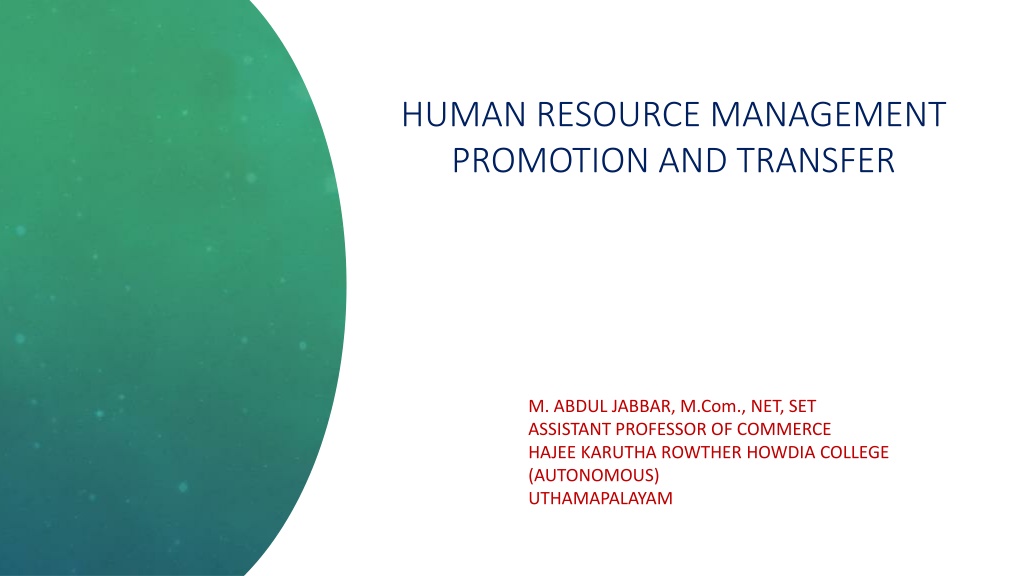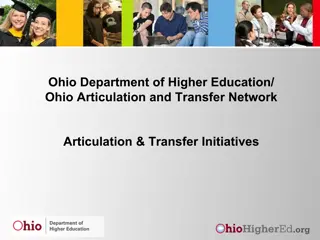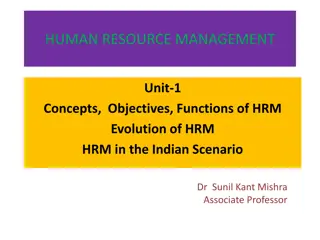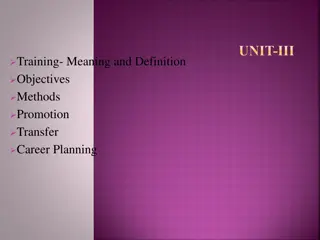Understanding Promotion and Transfer in Human Resource Management
Promotion in human resource management involves upward movement of employees to higher positions within an organization, leading to changes in salary, status, responsibility, and job grade. Two common bases for promotion are seniority and merit, each with its own advantages and disadvantages. While seniority-based promotion provides stability and fairness, merit-based promotion rewards performance and encourages efficiency. Organizations need to carefully consider these factors when promoting their employees.
Download Presentation

Please find below an Image/Link to download the presentation.
The content on the website is provided AS IS for your information and personal use only. It may not be sold, licensed, or shared on other websites without obtaining consent from the author. Download presentation by click this link. If you encounter any issues during the download, it is possible that the publisher has removed the file from their server.
E N D
Presentation Transcript
HUMAN RESOURCE MANAGEMENT PROMOTION AND TRANSFER M. ABDUL JABBAR, M.Com., NET, SET ASSISTANT PROFESSOR OF COMMERCE HAJEE KARUTHA ROWTHER HOWDIA COLLEGE (AUTONOMOUS) UTHAMAPALAYAM
According to Edwin B. Flippo, A promotion involves a change from one job to another that is better in terms of status and responsibility DEFINITION AND DEFINITION AND MEANING OF MEANING OF PROMOTION PROMOTION Promotion is an upward movement of employee in the organization to another job, higher in organisation s hierarchy. In the new job, the employee finds a change in salary, status, responsibility and grade of job or designation. As a whole, the organization perceives the staffing of vacancy worth more than the employee s present position. In contrast to promotion when the salary of an employee is increased without a corresponding change in the job-grade, it is known as upgrading . But when promotion does not result in change in pay, it is called dry promotion . Promotion is a method of internal mobility.
Bases of promotion Organisations adopt different bases of promotion depending on their nature, size, managerial policy etc. The well-established bases of promotion are seniority and merit. Seniority based promotion If seniority is the bases for promotion, an employee with the longest period of service will get promoted. Advantages It is easy to administer. It is easy to measure the length of service and judge the seniority. With the base of seniority there is no scope for favoritism, discrimination and subjective judgement. By seniority everyone is sure of getting promotion one day. Subordinates are more willing to work under senior boss who has given many years of service to the company.
Disadvantages It de-motivates the younger and more competent employees and it results in more employee turnover. The organisation is deprived of external talent which is very necessary due to technological advancements and multi-culture organisation. Judging the seniority is highly difficult as the problems like job seniority, company seniority, regional seniority, service in different organizations, trainee experience, research experience etc., will crop up.
Merit or competence-based promotion Merit based promotion occur when an employee is promoted because of superior performance in the current job. Merit means an individual s knowledge, skills, abilities as measured from his educational qualifications, experience, training, and past employment record. Advantages Promotion by merit is a reward to encourage those employees who make a successful effort to increase their knowledge or skill and who maintain a high level of productivity. It helps the employer to focus on talented employees recognize their talent and reward their contributions. Efficiency is encouraged, recognized and rewarded. Competent people are retained as better prospects are open to them. It inspires other employees to improve their standards of performance through active participation in all activities and putting in more efforts.
Disadvantages It is not easy to measure merit. Personal prejudices, biases, and union pressures may come in the way of promoting the best performer. When young employees get ahead of senior employees in the organization this creates frustration among senior employees .They feel insecure and may also quit the organization The past performance may not guarantee future success of an employee. Loyalty and length of service is not properly rewarded
Advantages of Promotion Plan It provides an opportunity to the present employees to move into jobs that provide greater personal satisfaction and prestige. It offers opportunities to management to provide recognition and incentives to the better employees. It generates within an organization beneficial pressures on work performance and desired behaviour of all its members. It serves as an orderly, logical and prompt source of recruitment for management to fill vacancies as they arise. Promotion fulfils the long-cherished desires in the lives of employees. Disadvantages of Promotion Plan Promotion promotes inbreeding in which the company will not have new blood and new thinking. Old habits and ideas are perpetuated. The system becomes stagnant, repetitious and very conventional. The newer employees are introduced at places where they are having little influence.
According to Edwin B. Flippo, Transfer is a change in job where the new job is substantially the equal to the old in terms of pay, status and responsibilities. Transfer is a change in job assignment. It does not involve a change in responsibility and status. A movement of an employee between equivalent positions at periodical intervals is called transfer. A transfer therefore does not involve a change of responsibility or compensation. Transfers are normally made to place employees in positions where they are likely to be more effective or where they are likely to get greater job satisfaction. Transfers may be either organization-initiated or employee-initiated. An organization may initiate a transfer to place employees in positions where they are likely to be more effective or where they are better able to meet work schedules of the organization. Employee initiated transfers also known as personnel transfers, it may be initiated for several reasons. These could range from wanting a change of boss or a change of location or to join their friends and relatives. DEFINITION AND DEFINITION AND MEANING OF MEANING OF TRANSFER TRANSFER
Types of Transfers There are different types of transfers depending on the purpose for which the transfers are made. Judging from the view-point of purpose, there are nine type of transfers. General transfer Production transfer Replacement transfer Shift transfer Remedial transfer Versatility transfer Punishment or Penal transfer Request or Personal transfer Mutual transfer
(a) General transfer General transfers are normally affected during a particular period of the year wherein all employees having completed a given period of service in a post or at a place are involved. Definite rules and regulations are to be followed in affecting such transfers. Such transfers are followed in big organizations, quasi-governmental organizations and government departments. (b) Production transfer Production transfers are normally made from one department to another where the need for the employee is more. This type of transfer is made to avoid lay-off of efficient and trained employees by providing them with alternative positions in the same organization. These changes help to stabilise employment in an organization and therefore require centralised control. Although it is called production transfer, similar situations can exist in non- manufacturing enterprises or divisions too where an employee is transferred from one department to another for similar reasons
(c) Replacement transfer These are transfers of long-service employees to similar jobs in other departments where they replace or bump employees with shorter service. Replacement transfers are affected to replace persons leaving the organization, due to resignations, retirements, dismissal or death. Quite often such transfers are affected to change a new employee who has proved to be ineffective in the organization. Even though the objective of these transfers is to retain the efficient and trained employees in this process some short-service employees may lose their jobs. (d) Shift transfer Shift transfers are transfers of workers from one shift to another on the same type of work. Workers generally dislike second or third shift as it affects their participation in community life. To minimise this, shift transfers are effected. Shift transfers also help workers to be out of routine fatigue.
(e) Remedial transfer Remedial transfers are transfers made to remedy some situation primarily concerned with employee on the job. Remedial transfers provide management with a procedure whereby an unsatisfactory placement can be corrected. Initial placement might be faulty, or the type of job might not suit his health in such cases the worker would benefit by transfer to a different kind of work. (f) Versatility transfer The objective of these transfers is to increase the versatility of the employee by shifting him from one job to another. In this way, the employee is provided a varied and broad job experience. This transfer is like a rotation transfers. Versatility transfers, besides resulting in greater satisfaction of the workers through job enlargement, also creates a work force which can be conveniently shifted to other jobs in time of necessity.
(g) Punishment or Penal transfer This transfer is made as punishments to erring employees. Quite often the employees are transferred from one place be another so that they are made to work in a situation of risks and hazards. Employees are posted to such places as a matter of punishment for the errors and omissions they have committed. Sometimes, transfer is used as a concealed penalty. A trouble-maker may be transferred to a remote branch where he cannot continue his activities. (h) Request Transfers This type of transfer is done on the request of the employee. It is normally done on humanitarian grounds to help the employee to look after his family and personal problems. (i) Mutual Transfers When transfers turn out to be mutual between two employees they are refered to as mutual transfers. Usually, the organization concedes to request of employees for transfer if another employee is willing to go to the other place.

























